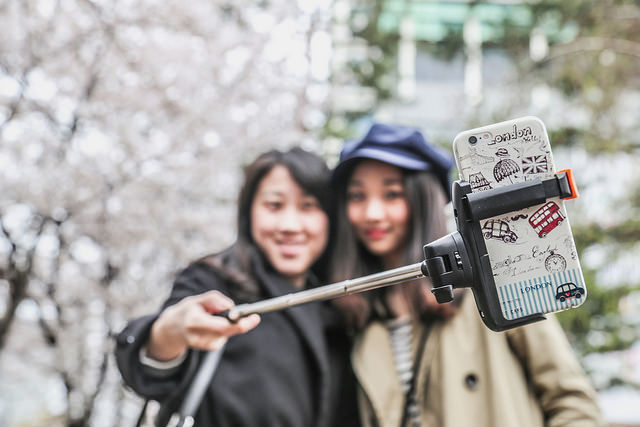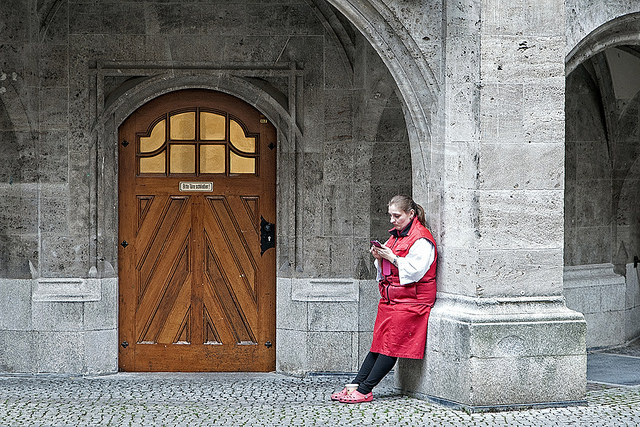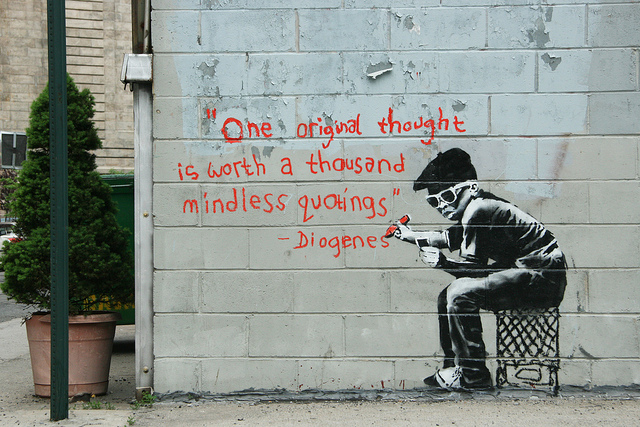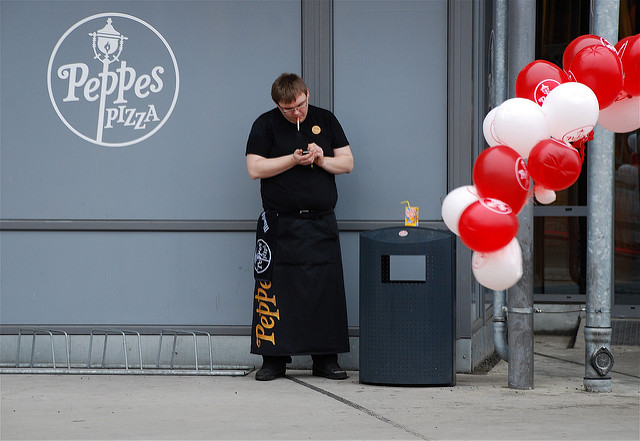Unlock the Magic in Your Story Now
Get the Free 20 questions to Ask Before Launching Your Idea workbook when you sign up for occasional updates.
Get the Free 20 questions to Ask Before Launching Your Idea workbook when you sign up for occasional updates.
Articles filed in: Strategy
The Heart Of Customer Loyalty
 Despite everything we know about the benefits of fostering customer loyalty, most of our marketing is designed to change what people think or do in the short term. We change the label from white to yellow to get a millisecond more attention. We offer discounts on product lines we want to shift and when we run out of reasons for people to buy, we invent them.
Despite everything we know about the benefits of fostering customer loyalty, most of our marketing is designed to change what people think or do in the short term. We change the label from white to yellow to get a millisecond more attention. We offer discounts on product lines we want to shift and when we run out of reasons for people to buy, we invent them.
If you’re playing the long game you have to dig deeper and think about changing how people feel—not just about your brand, but about themselves in its presence. A beloved brand aspires to change how people feel, not only to manipulate what people think and do.
People come back because they feel like it, not because we made them.
Image by Baily Cheng.
From Insights To Advantages
filed in Innovation, Strategy
 Chip Wilson discovered that women liked to look great when they exercised and feel comfortable when they didn’t. Lululemon pioneered the activewear trend way back in 1998—a market that is predicted to grow to $178 billion by 2019.
Chip Wilson discovered that women liked to look great when they exercised and feel comfortable when they didn’t. Lululemon pioneered the activewear trend way back in 1998—a market that is predicted to grow to $178 billion by 2019.
Dave Gilboa worked out that we hate feeling ripped off and paying as much for glasses as for an iPhone. Warby Parker cut out the middleman and married great design with fair prices.
Sarah Regan realised that people didn’t always want to send a dozen roses. The Little Flowers business has blossomed, delivering small bunches of seasonal, local flowers for $30.
Travis Kalanick figured out that we hate waiting and uncertainty. The Uber app added killer features that fulfilled the wants and needs the taxi industry hadn’t addressed.
Steve Jobs understood that how it feels matters just as much as how it works. That single insight drove everything that Apple did, making it the most beloved brand and most valuable company in the world.
Our best ideas are born from unmet needs. The insights we gather today about what people want and how it could exist are the competitive advantages of tomorrow.
Image by Ross G. Strachan.
How To Reach Your Customers
 Here’s how our customer’s time was spent across the various media platforms in 2015.
Here’s how our customer’s time was spent across the various media platforms in 2015.
Print 4%
Radio 13%
TV 36%
Internet 22%
Mobile 25%
Here’s where we spent our dollars trying to reach them.
Print 16%
Radio 10%
TV 39%
Internet 23%
Mobile 12%

While we’re spending money in places where fewer of our customers are engaging (print and TV), we’re missing opportunities to meet them where they are (mobile). According to Meeker’s Annual Internet Trends Report, this represents a $22 billion opportunity in the US alone.
The best way to reach your customers is to meet them where they are.
It might not be where you assumed they’d be.
Image by Pieter van Marion.
Quiet Success
 Success for my parents, was having a fair day’s work to do, for a fair day’s pay. Success was having money left in your pay packet at the end of the week after the bills were paid. Success was having the wherewithal to take care of your family and contribute to your community—often in ways that were not measured in pounds, shillings and pence.
Success for my parents, was having a fair day’s work to do, for a fair day’s pay. Success was having money left in your pay packet at the end of the week after the bills were paid. Success was having the wherewithal to take care of your family and contribute to your community—often in ways that were not measured in pounds, shillings and pence.
Success was doing work you were proud to have done.
Now success is measured in every conceivable data point and by comparison. We try to keep pace and outdo, forgetting that how we measure success is a choice.
Success doesn’t have to manifest in the form of million dollar launches, grander titles, the most followers, or in the business class lounge. Loudest doesn’t always win.
In fact, some of the most successful people you know whisper.
Image by Joanna Keler.
What’s Your Big Idea?
filed in Storytelling, Strategy
 Every great brand leads with one big idea. The big idea is what the brand stands for—it’s core belief. Articulating the big idea is harder than you think, living it every day is even harder than that.
Every great brand leads with one big idea. The big idea is what the brand stands for—it’s core belief. Articulating the big idea is harder than you think, living it every day is even harder than that.
The brands that do have a much easier time differentiating themselves from the competition. Here are a few examples.
Starbucks—The local cafe should be a ‘third place’ between home and work.
Marie Kondo—Tidying up has the power to transform your life.
Warby Parker—Prescription eyewear should be stylish and affordable (under $100).
Go-To—Skin care should be free of confusion, cruelty and faux-science.
Lune—A great croissant is created with attention to detail at every stage in the making process.
Patagonia—Business must inspire and implement solutions to the environmental crisis and do no harm.
School of Life—Emotional Intelligence is a life skill that everyone needs help to develop.
Banksy—Art belongs to the people.
What’s your big idea?
Image by carnagenyc
Where Do You Want Your Story To Land?
filed in Storytelling, Strategy
 This is the story of two independent bookstores located on the same street, separated by a walkway and three cafes. The bigger store has a more spacious feel. They display most of their books face out in clearly labeled categories. New releases are showcased in easily accessible, neat piles on tables. The whole place has a curated, orderly feel. The second store is smaller and more disheveled. You get a sense that the books could be used even though they are new. Only one or two copies of a title are stocked. The books are cataloged haphazardly and displayed spine facing out. The experience of finding the right book is akin to going on a treasure hunt. It’s obvious that each store is serving customers with different worldviews
This is the story of two independent bookstores located on the same street, separated by a walkway and three cafes. The bigger store has a more spacious feel. They display most of their books face out in clearly labeled categories. New releases are showcased in easily accessible, neat piles on tables. The whole place has a curated, orderly feel. The second store is smaller and more disheveled. You get a sense that the books could be used even though they are new. Only one or two copies of a title are stocked. The books are cataloged haphazardly and displayed spine facing out. The experience of finding the right book is akin to going on a treasure hunt. It’s obvious that each store is serving customers with different worldviews
The bigger store gets more foot traffic. More people are inclined to drop in during the last ten minutes of their lunch break to browse and while away some time. It’s easy to assume that the bigger store is more successful because it looks like they have more customers. But that doesn’t necessarily mean they sell more books.
Two important takeaways. Different customers respond to different stories. If you want your story to resonate you need to be really clear upon which ears and in whose hearts your story will land. And it’s possible for a business to be sustained and thrive with a small number of loyal customers who love it. Unicorn status is overrated.
Image by Elisa Banfi.
The Things You’re Not Measuring
 The more data we have the more we think we need. We measure everything from email open rates to foot traffic. We obsess over numbers of followers and rates of growth. And yet we often forget to take stock of the things we’re proud to have done and the ways we’ve made a difference.
The more data we have the more we think we need. We measure everything from email open rates to foot traffic. We obsess over numbers of followers and rates of growth. And yet we often forget to take stock of the things we’re proud to have done and the ways we’ve made a difference.
Here’s your chance. Make a list of the things you’re proud you did over the past twelve months.
What’s the most important thing that needs to be on that list, but isn’t?
The clues you’re choosing to ignore in favour of what it seems important to know, are more powerful than you realise.
Image by Khánh Hmoong.
Your One And Only Shot
filed in Storytelling, Strategy
 Dave volunteered to fill in for another gym instructor at the last minute. He arrived late for class and was greeted by a full house of enthusiastic morning gym goers, weights at their feet, water bottles at the ready. He hit his first obstacle within minutes. The gym didn’t supply the workout music and there was no CD player. Dave only ever used CDs and had no backup music.
Dave volunteered to fill in for another gym instructor at the last minute. He arrived late for class and was greeted by a full house of enthusiastic morning gym goers, weights at their feet, water bottles at the ready. He hit his first obstacle within minutes. The gym didn’t supply the workout music and there was no CD player. Dave only ever used CDs and had no backup music.
He chased around the gym for ten minutes looking for alternative options, until one of the attendees handed him her iPhone loaded with a variation of the workout music on Spotify. Fifteen minutes in, his confidence shattered and rhythm broken Dave was undone. The unfamiliar variations of the tracks threw him. Everything began to unravel. In his attempt not to look stupid Dave had stopped thinking about the audience long ago and was now focused entirely on himself. He’d not only lost it, he’d lost them. It was the worst class he’d ever taught. The complaints from the attendees to the management flooded in.
You can probably empathise with Dave. When we are preoccupied with our emergencies, expenses, staffing issues, delivery delays and on and on, we can lose sight of the end goal. There is no bigger emergency than having no customers. Without customers there is no story to tell. Above all else we need to keep the customer top of mind. Just showing up isn’t enough. You need to tell your story like it’s your one and only shot to do it, each and every time. Act as if you won’t get a chance to tell it tomorrow.
Image by Daniel Diaz Vera.
 The sign had been hastily scrawled in blue biro. The letters gone over and over again to make them more visible to the passer-by. A short cut, that in the end didn’t give the benefit of a short cut at all.
The sign had been hastily scrawled in blue biro. The letters gone over and over again to make them more visible to the passer-by. A short cut, that in the end didn’t give the benefit of a short cut at all. My boys are lucky enough to have eaten pasta in Rome, croissants in Paris and hamburgers in New York. Yet, when the conversation turns to food memories, the one they treasure most is eating potatoes next to the Aga in a friend’s kitchen in Scotland.
My boys are lucky enough to have eaten pasta in Rome, croissants in Paris and hamburgers in New York. Yet, when the conversation turns to food memories, the one they treasure most is eating potatoes next to the Aga in a friend’s kitchen in Scotland.